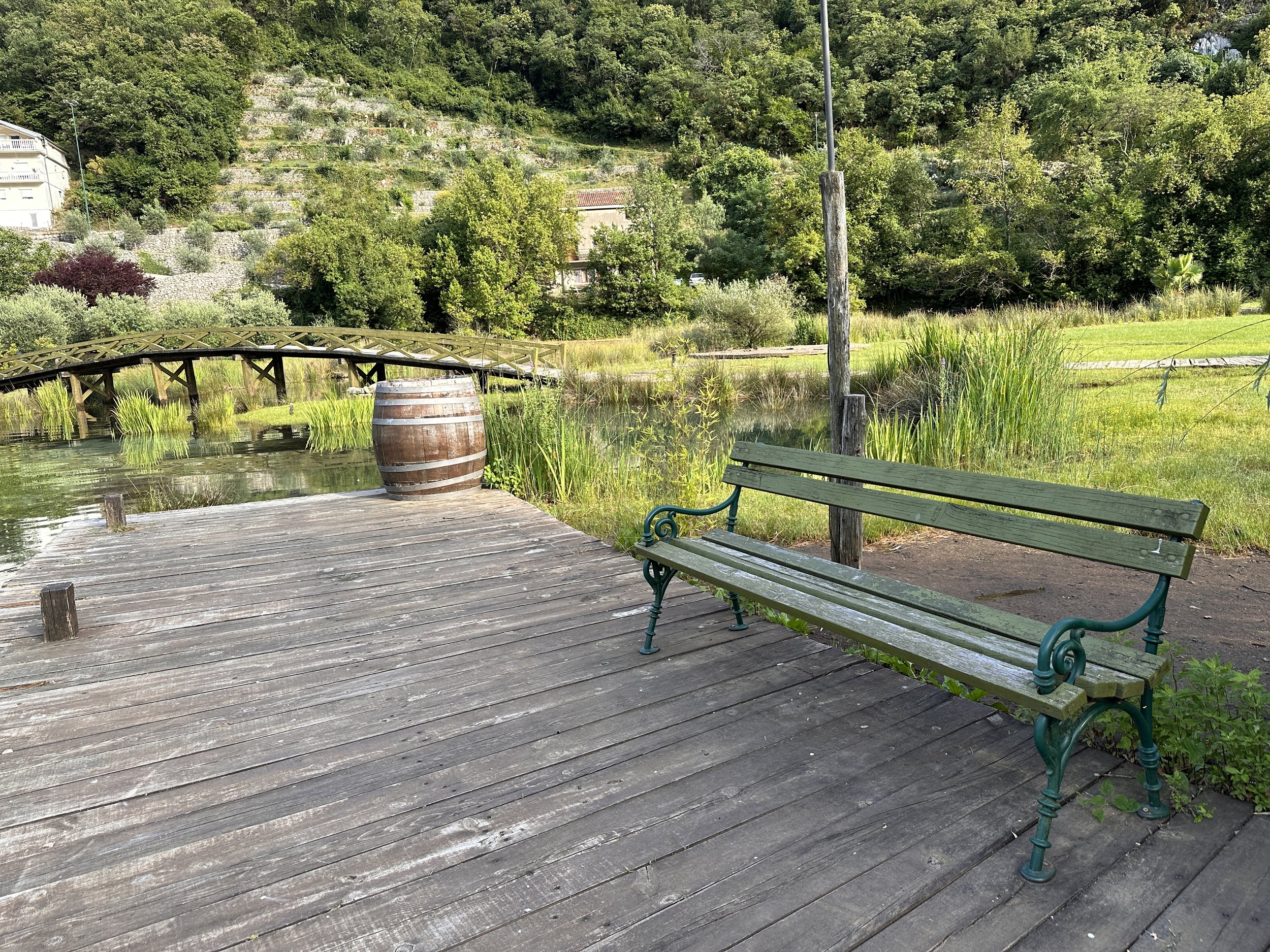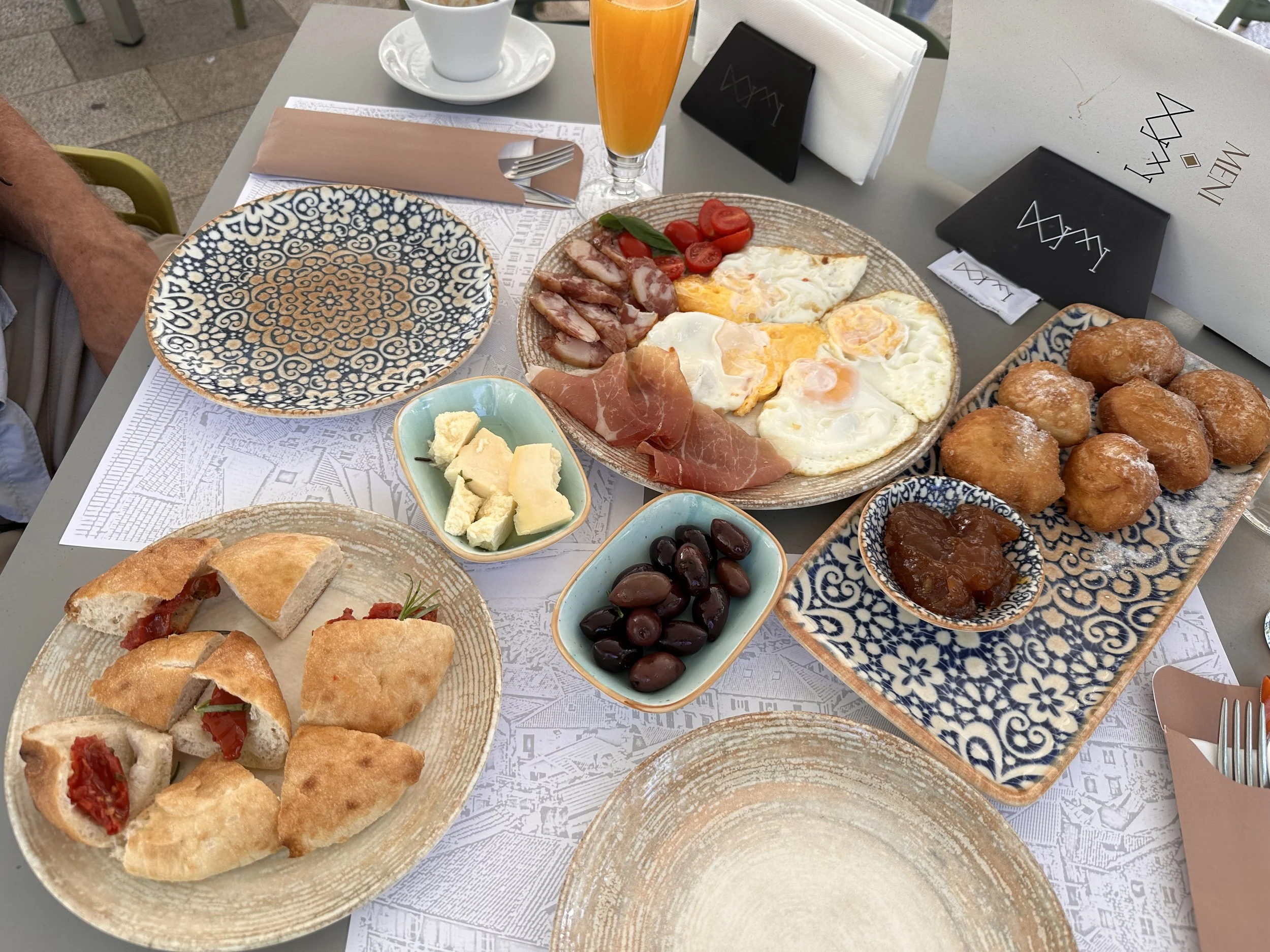More Montenegrin Musings
(and Many Mouthwatering Meals)
It’s been a VERY long time since I’ve sat down to write. I could say it is due to the exhilaration that comes with the long days of summer. I could say it’s because the heatwave takes a toll and zaps me of all my energy save for the effort of diving into the water. I could say it’s because I’ve been pleasantly distracted by having a boat guest aboard. All would be true. And then some. So let me just pick up where I left off in the Bay of Kotor, Montenegro.
Traditional Montenegrin breakfast
We moved onto anchor in the bay of Morinj somewhere around the first of July and found an area with calm water at least, if not a very quiet anchorage. The bay filled up each morning with day boats, jet skis, SUPs, swimmers, kayaks, hydrofoils, etc. I was constantly grinning from the shrieks of joy coming from the children playing in the water. We had a great time people watching - something we call “Boat TV”. We hung out there for 12 days; swimming, paddle-boarding and taking the dinghy on explorations to nearby communities.
We took Raki up a tiny creek, under a bridge and visited an old mill one evening which had been turned into a restaurant. The surrounding grounds were park-like and we enjoyed meandering along the paths towards the old, ivy covered stone building and relaxing on the landscaped terrace dining area alongside the creek.
















Ćevapi (pronounced CHAE-vap or CHAE-vap-ee)
We visited the town of Risan just 2 miles away on more than one occasion. Considered to be one of the oldest settlements in the area it is surprisingly non-touristy. We walked up Gabela Street, a narrow, quaint cobblestone path where traditional Montenegrin architecture transports you to another time. The street is lined with charming cafes, artisan shops, and local galleries. We stopped by a street vender selling everything from housewares to clothes and ate traditional Montenegrin street food called ćevapi - bite-sized, hand-shaped, case-less sausages made with a mixture of ground beef, lamb, and/or pork. They are served stuffed into flatbread and garnished with sliced onions and a sweet red pepper sauce.








We toured the Roman Mosaics on one visit which are the remnants of Villa Urbana, the house of a noble family from the 2nd century A.D. As you enter the Villa, you stroll onto a walkway that surrounds a central atrium. Roman houses had open air atriums in the middle and the rooms of the house were built around this central area. In the atrium there was a pool that collected rainwater which was used throughout the house by way of a channel which directed the water to the kitchen and bathroom. Roman houses were relatively advanced for their time. They had basic indoor plumbing and by the beginning of the 4th century they even had underfloor heating.
The floors of the rooms were decorated with mosaics - which I continue to be completely enchanted by. The most spectacular was the one with the representation of the god Hypnos, whose base is made of a small white mosaic dotted with symmetrically arranged geometric motifs (circles, rhombuses, triangles), and inside some of them are circles with a leaf rosette in the center. The inner field is made of 16 diagonal pieces intersected with a stylized floral design in white, green, blue, red and black. In the very center, the Roman God of Sleep, Hypnos, is depicted. He is represented as a half-naked young man reclining with his legs crossed and folded wings behind each shoulder. Hypnos originated from Greek mythology and was said to be a beautiful young man who touched the eyes of tired people with a twig dipped in the River of Oblivion and put them to sleep! (A drink from said river and you experience complete forgetfulness!)










I love that a beautiful image or pattern can emerge from the placement of tens of thousands of (in this case) small stones. I’ve discovered that they can be made of everything from colored stones or ivory to seashells or ceramics. Typically held together by plaster or mortar, mosaics are one of the most intricate and mysterious decorative forms. The patterns range from the very simple to the very complex, and they can depict saints, geometric figures, mythological creatures and abstract designs alike. The sheer size and breadth of detail in each of these rooms was phenomenal. These ruins are rightly considered the richest heritage of ancient culture throughout all of Montenegro.
We stopped by Risan several times while anchored in Morinj. One early morning we decided to dinghy over just to take a walk. It was gearing up to be hot even though the sky was slightly overcast. We tossed our raincoats into Raki just in case and ten minutes later we were walking along the streets of Risan. Five minutes later it started to drizzle. Ducking into a cafe for a coffee we thought we’d wait it out. But it continued to rain - getting heavier and heavier. At some point we realized we’d left all of Meraki’s hatches and portholes open. Not wanting to delay further we ventured out into the deluge and headed home. We could barely see through the sheets of rain blowing directly into our faces and were soaked to the skin within seconds. The downpour was intense and also beautiful. The raindrops bounced off the sea surface and appeared to hover in mid-air momentarily before coalescing with the ocean.




Upon arriving home we discovered the boat was practically flooded. Both sleeping cabins and all the bedding was drenched, the helm was awash with water - the dash, the seat and the floor. The stairs, the head, and the galley were also soaked. and the couch and settee cushions along with all the throw pillows were waterlogged! It took all the towels, cleaning clothes, sponges and mops we have onboard to get the boat even close to dry. As it continued to rain, we discovered that one of the hatch drains in the master cabin was leaking. (Only the one on my side of the bed - naturally) Though we attempted to try to dry the sheets, the rain continued and my side of the bed remained beneath a constant running faucet. All of our foul weather gear and waterproof clothing was dug out of the recesses of the boat and spread out in layers on my side of the bed. We tried to dry and then duct tape a plastic garbage bag over the hatch outside on the foredeck - it only blew off a couple of times. I slept in the other cabin until we could get the parts needed, and a dry day, to repair the leak.





I’ve learned what it’s like to be in a torrential rainstorm on the ocean in a 10’ open skiff. I’ve learned it takes a very long time to dry 7 sheets, 12 towels, 9 raincoats, and multiple layers of clothes in a very small, closed, humid, tiny home. I’ve learned to check weather forecasts before leaving the boat - even for just an hour. I’ve learned it’s really terrific having a comfortable bed in a second cabin. And I’ve learned how to re-seat an elbow joint (thankful for small hands) in a tiny overhead ceiling compartment while standing on the bed. Lessons #3001-3005.
Another excursion took us to the tiny maritime village of Perast, population 269. Here we wandered the waterfront and sampled more of the local dishes. We learned Perast was home to one of the first nautical schools where Venetian, and later Russian, sailors came to learn maritime skills from local seamen, cartographers and engineers. At the height of its power, in the mid 1700's, Perast had four important shipyards and a fleet of around 1,000 ships based in its harbor.







We had now spent a month in Montenegro. It’s so great to be able to stay somewhere for awhile. We generally feel the pull to keep moving because of the Schengen Agreement and it’s strict time limit for non-EU citizens to stay in these countries.





For those of you who don’t know, the Schengen Agreement, signed on June 14, 1985, is a treaty that led most of the European countries towards the abolishment of their national borders, to build a Europe without borders known as the “Schengen Area”. Signed in Luxemburg, initially by only five EU countries, the agreement remains one of the world’s biggest areas that have ended border control between member countries. The border-free Schengen Area guarantees free movement to more than 400 million EU citizens, along with non-EU nationals living in the EU or visiting the EU as tourists, exchange students or for business purposes (anyone legally present in the EU). This enables every EU citizen to travel, work and live in an EU country without special formalities. Today, the Schengen Area encompasses most EU countries, except for Bulgaria, Cyprus, Ireland and Romania, however, Bulgaria and Romania are currently in the process of joining the Schengen Area. On January 1st of this year Croatia became the newest member to join the Schengen area. Additionally, there are non-EU States: Iceland, Norway, Switzerland and Liechtenstein, which have joined the Schengen Area.
This makes great sense for EU residents but for cruisers it is problematic. Being non-EU citizens, we can visit any of the 27 member states of the Schengen Zone for a total of 90 days within the previous 180-day period. The easiest way to think of this is that you can visit for 3 months and then you have to leave for 3 months before you can return. But you can also bounce back and forth between Schengen and non-Schengen countries — you just need to keep track of all your dates of entry/exit.
If you stay more than 90 days within a 180 day period you’ve effectively breached the 90/180 rule and could be deported, fined or banned from entering the Schengen Area for several years. The penalty varies from country to country - in some places they will actually confiscate your vessel! The ‘Schengen shuffle’ as it is referred to by non-EU cruisers, has made our adventuring in the Mediterranean difficult. Tom built a spreadsheet for us to keep track of our Schengen days which has been super helpful as we have moved in (Greece), and out (Turkey, Albania and Montenegro) of the zone since arriving on April 27th. I believe we have about 28 or 29 days left and we are still hoping to visit Croatia and Malta this season.
This is the tuna aisle at the local supermarket.
So after a lovely, long, lazy stay in Morinj we began cruising again and made our way towards the Tivat area. Here we trekked across the city shopping at all the marine stores, and even rented a car one day just so that we could go to the big hardware store - which is way too far out of the city to walk to in this heat.
Parts were eventually found. Repairs were made. And planning has begun for our upcoming cruise to Croatia.
Stay tuned…..


Note: photo captions will not appear if viewing on a cellular device.











